The dawn of civilization more than 8000 years ago
In the view of some archaeologists
If we say that the Chinese civilization was formed 5000 years ago
Then the ruins of Jiahu tell us
More than 8000 years ago
The dawn of civilization has appeared
Liu Zhengguo held the instrument to his mouth, and the audience was quiet. A string of loud and clear voices floated out. On September 28, Liu Zhengguo played a piece of music tailored for this instrument on the special program "Why China" of Dongfang Satellite TV.
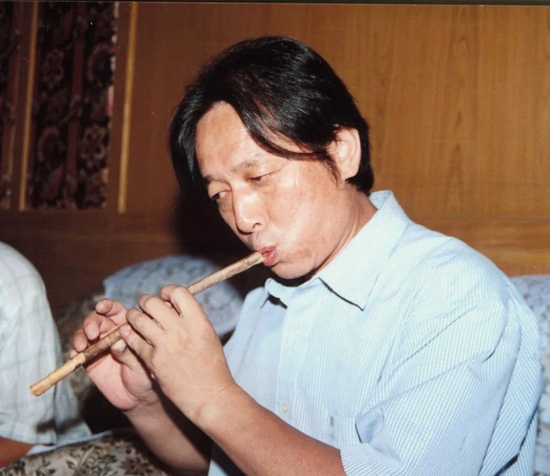
In July 2001, Liu Zhengguo measured the sound of the second batch of bone flutes ("bone Yue") unearthed at the University of Science and Technology of China. For drawing/Liu Zhengguo
This musical instrument is only about the length of chopsticks. It is made of the big eagle's ulna. It is warm and light yellow. He called it "bone Yue" (the same sound as "Yue"), and more people called it "bone flute", which originated from Jiahu, Wuyang, Henan. Eight or nine thousand years ago, Jiahu ancestors invented this musical instrument.
In 1986, the bone flute was first unearthed in the ancient tomb of Jiahu Site in Wuyang, Henan Province. At that time, people used the ulna of birds such as red crowned cranes as materials, cut off the joints at both ends, take a straight bone in the middle, and drill two to eight holes to make instruments with accurate scales. In 2001, Liu Zhengguo, a distinguished professor and performer of Shanghai Normal University, raised his bone flute for the first time, and sounded the sound eight or nine thousand years ago.
Jiahu is famous for its bone flute. This site is regarded as one of the most important archaeological discoveries in the early Neolithic Age. In 1999, the British magazine Antiquities published the research results of Jiahu Bone Flute, and took the picture of the bone flute as the cover to open the global popularity. Because of the bone flute, inscriptions on bones and tortoise shells, turquoise ornaments and other cultural relics, the Jiahu site shows a relatively developed material and spiritual culture. This site is 9000 to 7500 years old. Eight or nine thousand years ago, the degree of social development in China was far beyond our imagination.
According to some archaeologists, if the Chinese civilization was formed five thousand years ago, the Jiahu site tells us that the dawn of civilization appeared more than eight thousand years ago.
Since this year, the topic of "Exploring the Origin of Chinese Civilization" has attracted more and more attention. The Project of Exploring the Origin of Chinese Civilization, which has been proved by archaeology for 5000 years, has been known to the public. Archaeologists have long traced the search for the origin of civilization back to 8000 years ago. Through Jiahu, we can see how the most leading ethnic group lived eight thousand years ago.
The most striking evidence
Liu Zhengguo still remembers the first time he touched the Jiahu bone flute. It was a hot day in July 2001. He was in Hefei when he received an invitation from the University of Science and Technology of China to go to the expert building of the university. There were three bone tubes on the table. He just came back from the archaeological site of Jiahu last month, and professional recording equipment and a computer were also moved to the room.
He was invited to test the bone flute. He is a well-known performer, specializing in flute, but has studied ancient musical instruments such as Yue and Chi. For two consecutive nights, he successively played three unearthed bone flutes, which are precious cultural relics with a history of eight or nine thousand years. He trembled when he picked them up.
The three bone flutes are respectively non hole, two hole and seven hole, and the most expected one is the seven hole bone flute. The seven hole bone flute is brown, bright, smooth, simple and beautiful. It was once broken into two parts, and now it has been repaired. After thousands of years of burial, the bone flute has been close to petrification, with a slightly higher tone. Liu Zhengguo blew on his mouth, and the voice was clearer and louder than he thought.
In those two nights, he never tired of playing more than ten pieces of music, all of which were folk music such as "Butterfly Lovers", "Yimeng Mountain Minor", and "Spring River Flower Moonlight Night". He changed the playing angle over and over, tried various palace tunes, and tried to exhaust the possibility of bone flute sounding. The more he played, the better, "better than silk and bamboo". At last, he boldly tried the more complicated "Fanqi Diao" - to perform a tune of a Qupai in seven keys, and finally return to the starting key through seven repetitions, which is a superb folk performance skill. The seven hole bone flute has completed the complex process of "seven tune restoration". Liu Zhengguo came to the conclusion that seven voices were ready, which was amazing.
Wang Changsui, a professor in the Department of History and Archaeology of Science and Technology at the University of Science and Technology, presided over the test, and Zhang Juzhong, a fellow professor, was the leader of the archaeological excavation of Jiahu Site. In 1984, when the Jiahu Site was excavated for the second time, Zhang Juzhong had just graduated from the Department of Archaeology of Zhengzhou University and entered Henan Archaeology Institute for two years. He was the deputy director of the first research room, and he entered the Jiahu Site for the first time as the actual person in charge of the archaeological excavation site. Up to 2013, he led seven excavations of Jiahu Lake and was the person who knew Jiahu Lake best.
Jiahu Site is located in Jiahu Village, Wuyang County, Luohe City, Henan Province. It is located between the Yellow River and Huaihe River. In ancient times, the water system was developed and the terrain was flat, making it a livable place. To the north of the Jiahu site is the wide Shahe River, which surges down from the northwest to the east. Huihe River meanders across the west of the site and flows into Shahe River. The Nihe River in the south is the nearest to the site, only one kilometer, and runs through the whole Wuyang County. There is a small lake in the southwest of Jiahu Village, namely Jiahu Lake. The surrounding area of Jiahu Site can be rated as rich in water and plants, animals and plants. However, it is also a place of flooding, and finally abandoned due to a huge flood.
Jiahu Site was first revealed in the 1960s. When Zhu Zhi, the cultural relic cadre of Wuyang County Cultural Center, was sent to Jiahu Village to work, he often found remains such as burnt clay and red pottery pieces on the ditch ridge and well wall. In the mid-1970s, a big flood left only one house in Jiahu Village. When the bank was rebuilt, stone and pottery were unearthed, which attracted Zhu Chi's attention again. He reported to the Henan Provincial Cultural Relics Bureau.
In 1983, the archaeological excavation of Jiahu Site was officially launched. From 1983 to 1987, six excavations were carried out in Jiahu, and the most important cultural relics were discovered during this period. Since the 21st century, in order to cooperate with the students of the Archaeology Department in their internship and the construction of the Site Park, the last two excavations of the Jiahu Site have been carried out so far in 2001 and 2013.
Archaeologists found more than 40 bone flutes and a large number of tortoise shell fragments at the Jiahu site, some of which left human carved symbols. There were more than 5000 pieces of pottery, stone, bone and other unearthed objects. The total area of the eight excavations is about 3000 square meters, slightly less than half of the football field, accounting for about 1/18 of the total 55000 square meters of the site. For archaeological sites, this is a relatively full excavation. Many large sites have been uncovered for half a century.
In the archaeological history of China, Jiahu Site is one of the most developed ancient settlements in the period of eight or nine thousand years ago. At that time, the Neolithic Age had just been unveiled for more than 2000 years, and human beings had just come out of caves, and were clumsily developing agriculture, trying to plant plants and domesticate animals. However, Jiahu shows a face that is not completely primitive and backward, which goes beyond people's understanding of the initial stage of civilization.
"In my opinion, it was one of the greatest discoveries. The production of pottery, bone ware and turquoise, especially the unearthed objects related to astronomical calendar and divination, had a great impact on us." Han Jianye, a professor of the Department of Archaeology and Museum at the School of History of Renmin University of China, believes that Jiahu is the most shocking and direct evidence of the eight thousand years of the origin of Chinese civilization.
In October this year, on the ground of Jiahu Site, a Jiahu Site Museum overlooking the splashing water drops was ready for trial operation. Wu Yanfang, director of the office of the Jiahu Site Management Committee, told China Newsweek that the splashing water implied that Jiahu culture was "the source of nine thousand years of civilization". Jiahu Site Museum is located in the interior of Jiahu Archaeological Site Park. The most attractive landscape in the 284 hectare site park is undoubtedly a protected excavation site. A wooden plank road runs through the excavation area, so visitors can go deep into the first archaeological site. Representative copies of cultural relics are restored to the state when they were unearthed, showing a realistic sense of the scene.
Wu Yanfang said that the Jiahu Site Museum will have more than 400 collections available for exhibition, including charred rice, carved symbols, groups of tortoise shells, forked bone vessels, pottery tripods, turquoise, etc. A seven hole bone flute can be called the treasure of the town hall.
Bone flute or bone Yue?
The research on Jiahu bone flute has continued to this day. It lengthens the history of Chinese music, brings fresh elements to Chinese archaeology, and makes our imagination of ancient society more concrete and vivid. "At that time, people's spiritual life should be rich and comfortable. Although the material conditions are not rich, they are far from the barren and boring original scene we imagined," said Zhang Juzhong, professor of the Department of Science and Technology History and Archaeology of the University of Science and Technology of China and leader of the archaeological excavation of the Jiahu site.
The bone flute appeared in the fourth excavation of Jiahu Lake in the spring of 1986. On May Day, archeologist Yang Zhenwei and technician Jia Fenliang came to Zhang Juzhong and said that they had dug up two "flutes". Zhang Juzhong did not understand his meaning. He went down to the exploration party and looked at it. There were indeed two bone tubes on both sides of the tomb owner's left femur. Seven holes were drilled on one side of the bone tubes. It looks like a flute, but it has no holes for blowing and flute membrane, which is obviously different from the modern flute; It is also not a flute, because there is no mountain pass for playing.
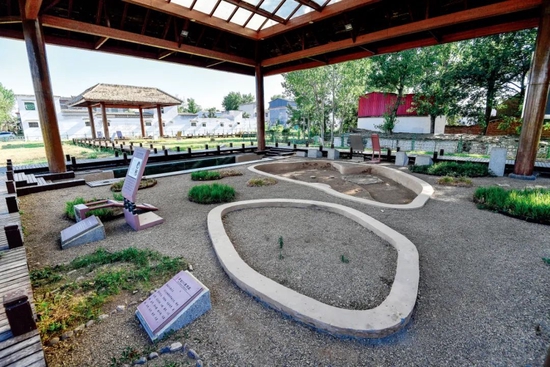
A corner of Jiahu Conservation Exhibition Area. Picture/A corner of the exhibition area of Jiahu Conservation in China. Figure/Visual China
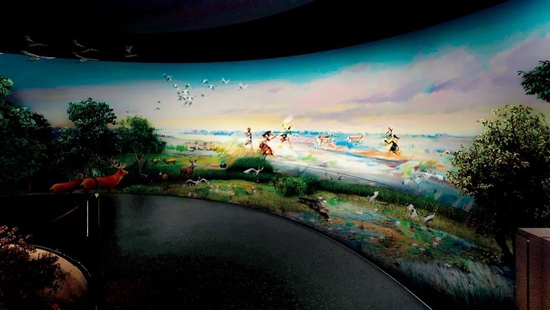
The "Nine Thousand Years of Jiahu" Immersive Theater in the Jiahu Site Museum. Picture/The "Nine Thousand Years of Jiahu" Immersive Theater in the Jiahu Site Museum of the Jiahu Site Office. Figure/Jiahu Site Office
More bone tubes have been unearthed one after another, but we don't know what to call them. Some of them are recorded as "perforated bone tubes", some as "flute shaped instruments", and some as "bone flutes".
It happened that in August of the same year, a group of authoritative experts in the field of Chinese music history came to Zhengzhou to attend the conference commemorating the 450th anniversary of the birth of Zhu Zaiyu, a musician of the Ming Dynasty. Zhang Juzhong and two archaeologists from the same unit came to Zhengzhou International Hotel, where the musicians stayed, with a well preserved bone flute, and asked them to identify it. That night, they knocked on the door of an expert who lived on the first floor. The expert looked at it and shook his head. He said that the small holes and sharp sounds might not form a sound sequence. Maybe it was a bone whistle that imitated the sound of animals when hunting, not a musical instrument. A basin of cold water poured down, and they were embarrassed to find other experts to make a fool of themselves.
That year, rare cultural relics unearthed in various places will be brought to Beijing for inspection by top archaeologists. In the summer of 1987, Zhang Juzhong and the leaders and colleagues of the Henan Archaeological Institute went to Beijing with several unearthed objects to visit experts in the field of archaeology, ancient writing and music. The unearthed objects included the best preserved seven hole bone flute, three pieces of tortoiseshell with more shaped carved symbols, and a handle shaped stone ornament.
They found Xiao Xinghua, a researcher of the Chinese Academy of Arts. At the first sight, Xiao was surprised to see this bone tube. Because its structure is very similar to the Xinjiang Kazak musical instrument, the Spore, and the Tajik eagle bone flute, he called it bone flute on the spot. Xiao Xinghua took them to the Chinese National Orchestra to look for Liu Wenjin, the head of the orchestra. At the intermission of rehearsal, Liu Wenjin asked several orchestral players to try to play. The first six musicians didn't make any sound. The seventh musician, Ning Baosheng, took the bone flute and thought it was close to the Henan folk musical instrument "Chiao". He should play it sideways and try to tilt the nozzle 45 degrees. The sound came out, and the sound sequence was blown out, and the pitch was accurate.
Xiao Xinghua said that the symbol of measuring music culture is the formation of scales. In the late Paleolithic Age, the four tone scale appeared, which was mainly used in labor chants. In order to express more complex emotions with sound, human beings developed the four tone scale into the five tone scale, thus turning the music civilization into a new page. The test results of Jiahu bone flute show that it can play a complete and quite accurate pentatonic scale. It can be said that in the age of Jiahu Site, the ancestors living in the Central Plains entered the period of musical civilization early.
In the world, ancient ancestors of many continents invented bone flute respectively. The earliest bone flute found so far can be traced back to nearly 40000 years ago. In 2008, the archaeological team of Tibingen University in Germany found a bone flute about 35000 years ago in the cave of Hohlefels site in the southwest of Germany. The raw material is vulture wing bone, which is about 22cm long and has five pressing holes. There were 22 deer bone flutes unearthed in the Pyrenees Mountains of France about 30000 years ago, and in Austria, bone flutes made from the shins of reindeer 19000 years ago were also discovered. Some archaeologists believe that bone flute is probably the oldest musical instrument in the world.
A few months after seeing Jiahu Bone Flute for the first time, Xiao Xinghua appointed musicians Huang Xiangpeng, Tong Zhongliang and two engineers to go to Zhengzhou to measure the sound of the bone flute with Stroboconn flash spectrum sound meter, the most advanced sound measuring instrument at that time. For a whole week, they tested the sequence of bone flute and recorded the tune of Hebei folk song "Little Cabbage". Quite accurate pitch and solid and loud timbre shocked the people present. The preliminary research conclusion is that Jiahu bone flute is a kind of musical instrument, which can rewrite the history of Chinese music and has an important position in the history of world music.
Since then, in the field of music history, Jiahu bone flute has been regarded as the source of Chinese music civilization.
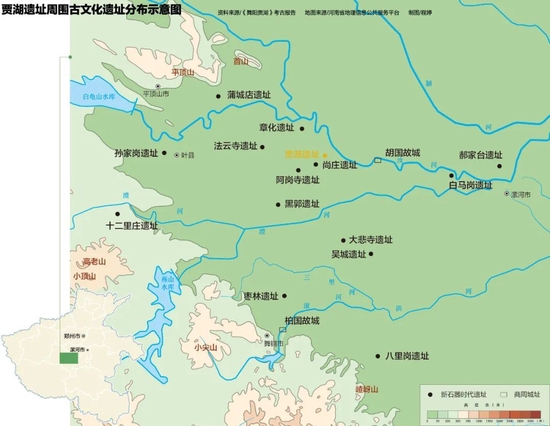
Another small thing that may not be small is worth mentioning. There have been different voices about the naming of bone flute in the academic circle, mainly from Liu Zhengguo's insistence. The flute appeared late in the literature. In the music records in the ancient books of the Pre Qin Dynasty such as the Book of Songs and Zuo Zhuan, many ancient wind instruments such as "sheng, xiao, yue, guan, chi" were involved, but there was no flute. Ma Rong of the Han Dynasty said in the Flute Fu that "the flute originated in the Han Dynasty". Huang Xiangpeng, the former director of the Music Research Institute of the Chinese Academy of Arts, once put forward a view on the naming of Jiahu bone flute. He believed that an ancestor had many descendants, and should not be named after one of them. Jiahu bone wind instrument is the ancestor of Chinese wind instrument, so it should not be named by the name that appeared late. However, he suggested that it was not necessary to demand the name of a certain descendant, but to call it "flute", which is the most natural and simple name at present. At that time, the discussion on the naming of Jiahu musical instruments was stopped. However, Liu Zhengguo believed that the name of the flute was also obviously difficult to escape the suspicion of "naming the ancestors after the descendants".
Liu Zhengguo explained to China Newsweek that the key to determining the name of a wind instrument lies in its shape and blowing method, especially the blowing method. The blowing method of Jiahu bone tube is quite different from that of flute. The flute has holes either vertically or horizontally, which can manage the air flow and make the sound pure and smooth. However, Jiahu bone tube has no blowhole, and its two ends are straight. It needs to be slightly tilted when playing, so that the breath can be unblocked. If it is blown vertically, the breath is blocked at the pipe end, and the pronunciation is squeezed too much, which is a forced voice. The volume is thin and weak, and the range is not wide enough. Because of the different pronunciation methods caused by blowing, wind instruments with similar shapes have different names, such as the difference between flute and xiao, pipe and chi. He therefore believed that since the playing method of Jiahu bone tube and flute was very different, it should have another name.
According to Liu Zhengguo's research, the bone canal of Jiahu should be Yue. There are records of "Yue is like a flute" in the literature, and the two are similar in appearance. Yue is an ancient musical instrument, which evolved into a palace musical instrument. It has been recorded in a large number of pre Qin documents, and it is also common in oracle bone inscriptions. However, after the Qin and Han Dynasties, Yue declined rapidly. In the Tang Dynasty, when the music culture was highly developed, there were no words. Guo Moruo once made a textual research on the "Yue" in oracle bone inscriptions. From the perspective of its shape, he thought that Yue was "like a braided tube". Since then, according to his opinion, the academic community believed that Yue was a wind instrument like the flute, and the single pipe theory of "Yue is like a flute", which had been circulating for more than 2000 years, was abandoned. Liu Zhengguo believed that Guo Moruo's statement was a misreading, relying only on the interpretation of the characters, and did not strictly research the history of music.
Zhang Juzhong also had no definite idea about the naming of Jiahu bone artifacts. He said that the archaeological community respected the opinions of the music industry. "When musicians reach an agreement, we'll follow them. If they don't reach an agreement, we'll call them flute for the time being."
After so many years, the academia did not discuss the naming again, as if it was just a matter of minor importance. Only Liu Zhengguo has been dedicated to this for many years. "As long as it is true, they will accept it sooner or later." He has mentioned many times to the Henan Provincial Museum that their Jiahu bone flute, the treasure of the town hall, should be attached to the "Yue" even if it is not renamed.
Jiahu's Spiritual World
Jiahu Bone Flute has a unique and advanced posture, but it is difficult to connect with or associate with the cultural phenomena of the previous and subsequent times. But the tortoise shell is different. It is destined to remind people of oracle bone inscriptions. Whether there was any writing on the tortoise shell was one of the things that the archaeologists in Jiahu worried about at that time. Archaeologist Jia Zhoujie wears a pair of reading glasses. He often turns the reading glasses into a magnifying glass to check whether there are any handwriting or scratches on the newly unearthed tortoise shells.
The breakthrough took place in May 1987, when a stone tool similar to a sword handle was unearthed in the tomb of an elderly woman, with a line of symbols clearly engraved on the curved surface at the top. The construction site was filled with joy. I bought wine and meat to celebrate. A more important discovery occurred the next morning, when Zhang Juzhong was cleaning up the buried tortoise shell in a tomb, there was a faint scratch on a piece of tortoise shell. He held back his excitement, took the tortoise shell to the pool beside him, dipped the bone brush in water to clean it, and a "eye" symbol emerged, almost identical to the "eye" in oracle bone inscriptions. Later, scores were also found on tortoise shells unearthed in other tombs, and more than a dozen symbols were also found on bone flutes, fork shaped bone tools, stone tools and pottery.
Oracle bone inscriptions were unearthed in the Yin Ruins of the late Shang Dynasty, about 3300 years ago. From Jiahu to Yin Ruins, five thousand years later, will oracle bone inscriptions be the descendants of Jiahu tortoiseshell symbols? In the opinion of Wang Wei, the president of the Chinese Archaeological Society, this is one of the important mysteries that affect the Chinese archaeological community
In 1987, Zhang Juzhong took the bone flute to Beijing for identification, and also took three pieces of tortoise shells. He visited many ancient philologists and got three opinions: one was represented by Hu Houxuan, an expert on oracle bone inscriptions, who believed that it was the writing of the time; One is represented by Li Xueqin, an ancient philologist, who believes that it should be a carved symbol with a certain nature of primitive characters; One, represented by Qiu Xigui, an ancient philologist, thinks it is just a sign. There is no final conclusion on whether Jiahu symbols are characters. However, many scholars agree that the function of Jiahu tortoise shell is similar to that of Yin Ruins tortoise shell, which is divination. Zhang Juzhong's point of view is that Jiahu's carved symbols can be used for recording events, counting and divination.
Jiahu tortoise shell also has a surprising design: the number of burial tortoise shells is an even number combination of 8, 6, 4, etc. Most of the tortoise shells also have different quantities of stones, which is obviously a reflection of the ceremony. There are two systems of divination in ancient China: divination and divination. Burning divination requires burning, such as oracle bones in Yin Ruins; Divination is closely related to divination, and the combination of numbers is used to predict good or bad luck, which has evolved into the Eight Diagrams. In his archaeological report, Zhang Juzhong proposed that the tortoise shells containing stones at the Jiahu site might be a method of counting. "Holy tortoise" is considered to be a spirit that can communicate with the ghosts and gods in the world. A specific number of stones are put into the tortoise shell, perhaps to communicate with the gods. However, some other experts believe that the stones may be used for making sounds, that is, the so-called "turtle bell".
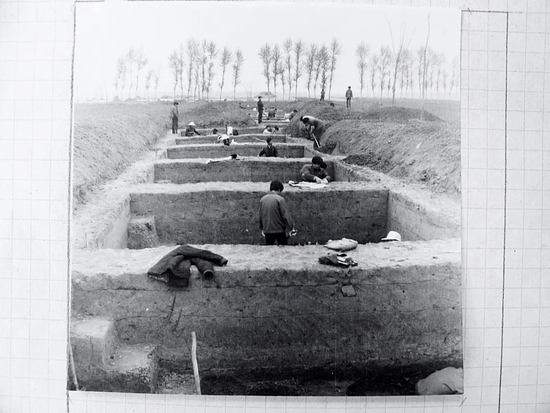
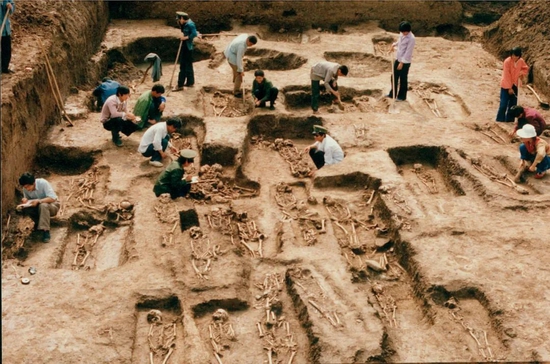
In the spring of 1987, the site of the sixth archaeological excavation of Jiahu Site. Drawing/Zhang Zhongzhong
Zhang Juzhong speculated that Jia Laker drank for psychic purposes. Archaeologists extracted chemical components similar to wine from Jiahu pottery, proving that Jiahu drank a mixed fermented drink made of rice, honey and fruit. Zhang Juzhong believes that the tortoise shells, bone flutes, fork shaped bone tools and other artifacts unearthed in Jiahu show that shamanism is prevalent in Jiahu society, and these artifacts may be props for witchcraft rituals. When presiding over the witchcraft ceremony, witches need to use some props that can make people reach the crazy state of divinity as soon as possible, so wine came into being, and drinking is often a very important procedure.
The emergence of divination, channeling and primitive religion is the result of the development of agriculture and productive forces.
Han Jianye, a professor of the Department of Archaeology and Museum at the School of History of Renmin University of China, said that agriculture originated around 10000 years ago, but its remarkable development was around 8000 years ago. The development of agriculture supported the origin of civilization. Jiahu has a kind of specimen significance - it is on the threshold of early agricultural development, from which we can directly see the changes brought about by agricultural development. As the late archaeologist Yu Weichao said, the earliest age of the Jiahu site is 9000 years, which is not far away from the era of agricultural origin. If compared with the late Paleolithic relics that have not yet appeared in agriculture, it is like two worlds. "From Jiahu, it is clear that the emergence of agriculture was indeed a great revolution, which quickly led to great progress in the whole society." Yu Weichao once wrote.
At that time, Jiahu ancestors had already eaten rice. The earliest single rice farming remains found in the north of the Yangtze River is only the Jiahu site.
When excavating that year, Zhang Juzhong asked that all things should be sampled back, and soil samples were no exception. They collected some pieces of burnt earth hardened by fire and put them in the office. One spring day in 1991, Pei Anping, deputy director of Hunan Archaeological Institute, came by Zhengzhou to visit Zhang Juzhong. During the chat, Zhang Juzhong asked how the ancient rice at Pengtoushan Site was discovered. It was an archaeological project presided over by Pei Anping, and the discovery of ancient rice had just been announced. Pei Anping said that there were rice husks and marks on the pottery. Then he pointed to the burnt soil on the floor and said that there might be some in it. Zhang Juzhong picked up a piece and broke it off. He really found an imprint of rice husk. They then broke it off all morning and found more than a dozen rice hull marks, which were later confirmed as rice after testing.
Jiahu was originally a fishing and hunting society. The reason why Jiahu began to cultivate crops and expand food sources must be that dramatic environmental changes have taken place. According to the results of environmental archaeology, strong low temperature events occurred between 8900 and 8700 years ago. The ancestors of Jiahu who lived in the transitional zone between subtropical and warm temperate climates must have difficulty in obtaining food in winter and spring. Then, the rapid and continuous warming from 8700 to 8500 years ago provided favorable conditions for the emergence of rice farming, and became a good opportunity to solve the problem of food shortage.
"At that time, Jiahu people were mainly engaged in fishing and hunting, but there were five categories of hunting, fishing, planting, breeding and gathering. The table was very rich and nutritious." Zhang Juzhong said with a smile. According to the measurement of human bones, the average height of men and women at the Jiahu site is 171cm and 167cm respectively, higher than the national average.
In some aspects of life, Jia Laker eight or nine thousand years ago is not much different from today. In addition to eating rice and drinking wine, they also raise pigs and dogs. Eleven dog burial pits were unearthed in Jiahu's residence and cemetery, where the complete bones of dogs were buried. This is a conscious treatment of domestic animals, indicating that dogs are not food, but domesticated partners. "When a dog is alive, he looks after his master's house and protects his yard. When he dies, he is buried beside the house or in the cemetery and continues to look after his master's house and protect his yard." Zhang Juzhong said.
Yuan Jing, a researcher at the Archaeological Institute of the Chinese Academy of Social Sciences and an expert in animal archaeology, said that the dogs unearthed at the Jiahu Site were the earliest domestic animals in China so far. "When wolves were first domesticated as domestic dogs, people at that time probably treated them as pets first. After all, this was the first animal that was close to people at that time. Besides, it would wag its tail, get close to people, lick people and other behaviors, which would increase people's liking for it and hope to be around at any time." Yuan Jing said that this kind of behavior came from the ancient people's understanding of friendship, and further enriched their understanding of friendship.
The understanding of rice, dog, human body and other aspects benefits from the intervention of scientific and technological archaeology. Zhang Juzhong believed that he was one of the people who recognized the importance of scientific and technological archaeology very early at that time, but in the excavation stage of the 1980s, "this string in his mind has not been tightened". In the research after the excavation, he found scholars in plants, animals, agriculture, minerals, ancient humans, chronology and other related natural science fields to separately study the unearthed objects stained with soil and transform the silent ancient objects into scientific achievements.
After the sixth excavation in 1987, Zhang Juzhong was engaged in research and archaeological report preparation for a full decade. It took a year just to figure out the pottery pot. It was like a jigsaw puzzle to put together pieces. Then we compared and analyzed the chronological order, arranged the sequence, classified the patterns, and separated the morning and evening. Tortoise shell fragments were also used for more than half a year, and dozens of tortoise shells were stuck. In 1999, the archaeological report "Wuyang Jiahu" of nearly 1.8 million words was finally published, laying a solid foundation for the Jiahu site in China's Neolithic research.
In 2000, two years after the completion of the archaeological report, Zhang Juzhong was transferred from Henan Archaeological Institute to teach in the Department of Science and Technology History and Science and Technology Archaeology of University of Science and Technology of China. The purpose of the department is to train scientific and technological archaeologists who understand traditional archaeology. The next year, for the first time, he took postgraduate students for field archaeological practice and chose the Jiahu site that he was most familiar with. After 14 years of dust laden, the Jiahu site ushered in the seventh excavation, and scientific and archaeological means were involved in all aspects for the first time. Plant archaeologists carried out flotation at the site, put the soil sample in the water tank, and the carbonized plant remains surfaced, obtaining a large number of plant remains. Paleoanthropologists conducted on-site identification of human bone specimens.
Where to come from and where to go
Jia Laker lived in Jiahu Village for 1500 years, until a flood destroyed his home. Then, where did Jia Laker migrate to?
After the Jiahu culture entered the Yangshao era, in the area where the Jiahu culture was distributed, there appeared Wuyang Guozhuang Site, Agang Temple Site, etc. Zhang Juzhong said that although there are some similarities between the new residents on these sites and the ancestors of Jiahu, such as rice planting, building houses and pottery making methods, these similarities are mainly caused by the common geographical environment, and it is difficult to prove that there is inheritance relationship.
However, there are more similarities between Jiahu culture and Dawenkou culture in the middle and lower reaches of the Huaihe River, especially in tombs and burial customs. Both of them have a large number of stone tools, bone tools and animal funerals. There are tortoise shells in the tombs, under which there are stones... The burial style and burial customs are exactly the cultural core that maintains a human community. Zhang Juzhong proposed a conjecture: after the ancestors of Jiahu left their homes, one of them moved eastward along the Huaihe River to Anhui, Shandong, Jiangsu and other places at the same latitude.
What about going west? Nanyang Basin to the east foot of Qinling Mountains is also the distribution area of Jiahu culture. The site of Dazhangzhuang in Fangcheng, 50 kilometers west of Jiahu Village, has a large number of factors directly inherited from Jiahu culture. This place just passes through the Yexian Fangcheng Corridor, which is the key link between the North China Plain and the Nanyang Basin. When the flood overflows and their homes fall, another Jia Laker may cross this corridor to live and multiply in a foreign country where his ethnic group lives.
The remains they left in Jiahu Village were not buried deeply, and the archaeological team found them less than half a meter after digging. Later generations found that Jiahu ancestors were a group of people with a special way of life.
Yu Weichao, an archaeologist, once described that the pottery of Jiahu is quite close to Peiligang culture in the Yellow River basin, while the custom of divination with tortoise shells and burial with roe teeth is close to the later Dawenkou culture in Shandong, northern Jiangsu and even the Xuejiagang culture in Anhui; The rice farming in Jiahu does not exist in other areas of the Yellow River basin, but is consistent with the Yangtze River basin. This means that Jiahu is a unique culture, including several factors of the two cultural systems in the middle and lower reaches of the Yellow River and the Yangtze River basin. Yu Weichao believed that the concept of "Jiahu Culture" proposed in the archaeological report was very correct.
In the area around Songshan Mountain in the middle reaches of the Yellow River, the archaeological culture dating from 8200 to 7000 years ago in the middle of the Neolithic Age is named Peiligang Culture, which is named after the earliest discovered Peiligang site in Xinzheng, Henan. The whole of China during that period was also generally summarized as the Peiligang era, and then entered the Yangshao era when civilization was formed. Jiahu Site overlaps with Peiligang Culture for a long time. When it was first discovered, it was naturally recognized as Peiligang Culture. However, with the emergence of some unique cultural phenomena, Zhang Juzhong believes that Jiahu culture is quite different from Peiligang culture and should be named Jiahu culture. Yu Weichao agreed. Others believe that the Jiahu site is similar to Peiligang culture and can be called the "Jiahu type" of Peiligang culture.
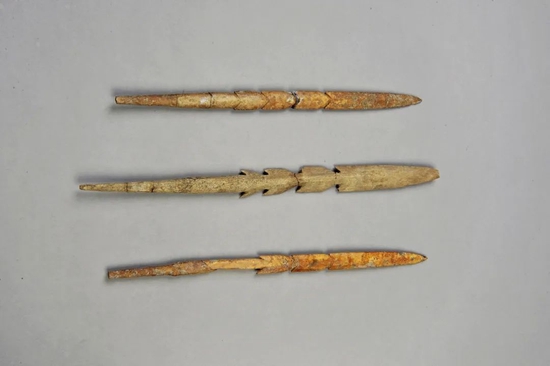
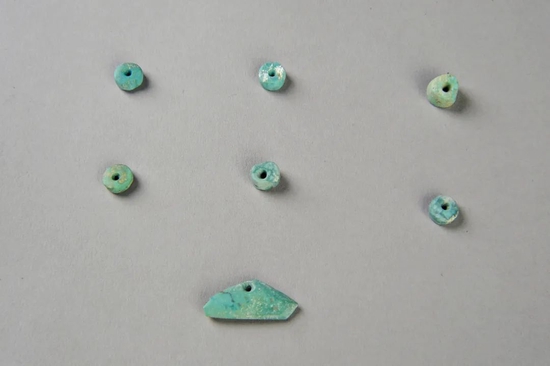
Bone darts (above) and stone ornaments (below) unearthed from the Jiahu site. Figure/Jiahu Site Office
In other regions at the same time, rice, millet, sacrifice and other relics also appeared in the archaeological culture of the Yangtze River basin, such as the Shangshan culture, the cross lake bridge culture, the Pengtou Mountain culture, the Gaomiao culture, and the Xinglongwa culture of the Liaohe River basin, which has a similar height of development with Jiahu. Han Jianye, a professor of the Department of Archaeology, Culture and Museum at the School of History of Renmin University of China, believed that more advanced ideas and knowledge had emerged at that time, including the outlook on the universe, religion, ethics, history, astronomy, mathematics, symbols, music and other knowledge. These more advanced ideas and knowledge systems, as well as more complex social forms, advance the origin of Chinese civilization to 8000 years ago, which can be regarded as the first stage of the origin of Chinese civilization.
Han Jianye believes that the most influential part of Jiahu culture lies in the world outlook, ethics and historical outlook of the spiritual world. "At that time, the world view of the round sky and the place was formed, and there were rules and moments related to the calendar. There were tortoise shells, stones and symbols for divination, and people began to respect the Heavenly Fathers and ask the Heavenly Divination. Ethics mainly refers to tombs. More than eight thousand years ago, there were very good earth pit tombs with vertical holes, which is a kind of thought of" bury in peace ". The tombs were arranged orderly and lasted for thousands of years. Chinese tombs have always been like this, reflecting the typical blood of kinship ethics" Predestination. The concept of history refers to a very powerful ancestor worship custom. Some ancestral tombs lasted for hundreds of years. At that time, there was no second example in the world. "
Zhang Juzhong is 69 years old and still has many questions about Jiahu. His team is studying the source of turquoise in Jiahu. In the archaeological report in 1999, Zhang Juzhong left a regret. He analyzed the whereabouts of the Jiahu culture, but did not explain its origin, because after careful consideration, he still had no clue. For more than 20 years, he has not let go of this problem, and now he has an outline in his mind. "There is a way of thinking, but it still belongs to the stage of scientific hypothesis, which is somewhat illusory." He told China Newsweek.
 渝公网安备 50010702504639号
渝公网安备 50010702504639号